Recent
History
The most recent eon of the Earth’s history, the Phanerozoic, begins with
the Cambrian period and it is preceded by a short period that predicted the
huge changes that would occur during this epoch – the Vendian.
Oxygen 1 – Carbon Dioxide 0
At the beginning of the Phanerozoic the quantity of oxygen would have
increased again, this time up to levels that were already close to the actual.
It is not known what drove to this occurrence, but it’s thought that the development
of the sulphate-reductor bacteria would have led to the accumulation of larger
quantities of species produced by the photo-synthetizers (like sulphur and
sulphurets), which left behind an excess of oxygen in the air. Again, the
erosion caused by the release of acid substances into the air (resulting from
reactions between the oxygen and other elements) and the subsequent release and
dispersion of nutrients would have favoured the growth of the number of living
organisms.
The proportion of carbon dioxide in the atmosphere declined again and,
more slowly, this evolution still prevails, encouraged by the increase of the
solar temperature and the need for keeping the thermal equilibrium that is felt
by the organisms on Earth. The combined action of the organisms provokes, this
way, the gradual reduction of the presence of carbon dioxide (greenhouse gas)
in the atmosphere.
Vendian
During the Vendian (between 650 million and 540 million years ago), a
completely new variety of soft-bodied organisms with macroscopic dimensions
appeared on the Earth’s surface. Its appearance may have been encouraged by a
mass extinction of previous organisms like the stromatolites, which may have been caused by the fall of a meteorite on Earth.
The continuous increase of the atmospheric oxygen would have given birth to the
appearance of an ozone layer. Because this ozone layer protected the biota from
the damaging effects of the ultraviolet radiation, it shall have also
contributed for the realization of this biological evolution.
Multicellular Organisms
The emergence of multicellular organisms had its origin in independent
cells that came together and formed cells’ colonies. Inside them, they started
to perform different and complementary functions, as it happens today in the
case of the porifera (sponges). It was a symbiotic mechanism, similar to the
one that made the eucaryots appear, that motivated
the emergence of the multicellular living beings. About 540 million years ago,
this primitive fauna became extinct, which is a fact that could also have been
caused by a meteoritic event.

The Salinella, one of the
strange organisms that emerged during the Vendian (Kerry B. Clark)
Explosion
of Marine Life
Cambrian
During the Cambrian, an explosive emergence of a vast variety of organisms
provoked the appearance of most of the direct ancestors of the great animal
groups (phyla) that we know today, as the arthropods endowed with external
skeletons (which included the trilobites and nowadays include the insects, arachnids, crustaceans, etc), the mollusks (ancestors of the
octopuses, snails, oysters, etc), the echinoderms (ancestors of animals like
the modern sea stars or the sea urchins and, through a parallel lineage, the vertebrates), the brachiopods (with few actual representatives),
among many others.
The growth of the quantity of atmospheric oxygen may have allowed the
emergence of organisms with big dimensions, because it enabled the development
of respiratory and circulatory systems, opposite to the skin respiration
previously dominant that is efficient only in small animals. The climate would
be hotter during this epoch, given the absence of continents at the poles that
could support the accumulation of glaciers (which, because they are white,
reflect the light back to space and cool the Earth) and the blockage of the
tropical waters by continents that prevented them from reaching the poles and
cool down.
Just like the life in the Vendian, the life of the Cambian also seems to
have crossed a phase of mass extinction, having been replaced by the life of
the Ordovician.
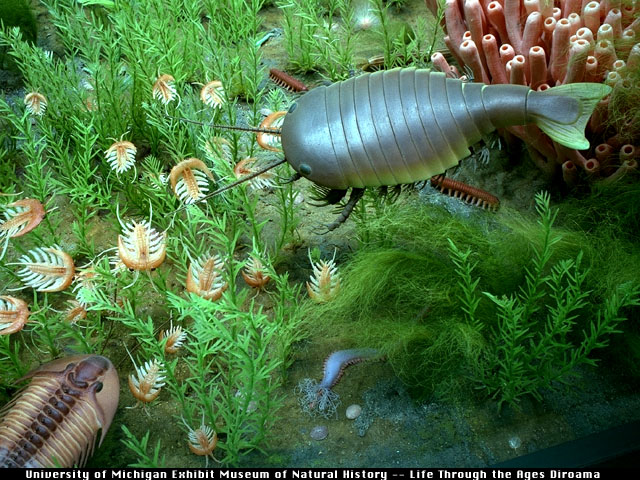
Life in the Cambrian
(University of Michigan)
Ordovician
During the Ordovician (which began about 505 million years ago) emerged
the first vertebrates (as the several classes
of fish) and were developed the cephalopod mollusks (which today include the octopuses, the squids and
the nautiluses) that, along with the vertebrates, were the only group of
animals to reach a high rank of intelligence. Across the eras, the development of the
intelligence was gradually endorsed through the natural selection mechanism –
the one that determines that the organisms that are more able to dominate and
modify the environment have higher chances of surviving, when they compete with
other organisms.

Life in the Ordovician
(University of Michigan)
Sighting
Land
Silurian
During the following period, the Silurian (which began 440 million years
ago), there would have emerged the first land plants, which were still
unprovided with leaves. They would be equipped with primitive water-pumping
systems (the ancestors of the roots) and would thrive mainly at the shores of
the bogs.

The Cooksonia, a plant of
the Silurian that inhabited the shores of the bogs (Adrian Sington)
Devonian
However, only during the Devonian (which began 410 million years ago)
the land plants expanded in a more remarkable way, having increased the
proportion of occupied lands and grown in size and variety. It’s thought that
the ferns were particularly abundant.
With the aim of exploiting this new and untouched food source, they also
appeared the first land animals. The arthropods, including unwinged insects and, more remarkably, the myriapods (millipedes and centipedes), were
the pioneers of this exploitation, having some of them reached enormous sizes
(up to 2 metres long) due to the absence of predators. Nowadays, the land
arthropods are small due to their heavy external skeletons, being preferable to
become nearly undetectable in front of their lighter predators.
Little after the arthropods, they emerged the first land vertebrates –
the amphibians. This new class of animals
developed from fish that presumably had acquired the capability for breathing
the oxygen of the atmosphere (lunged fish), which gradually transformed their
fins into legs.
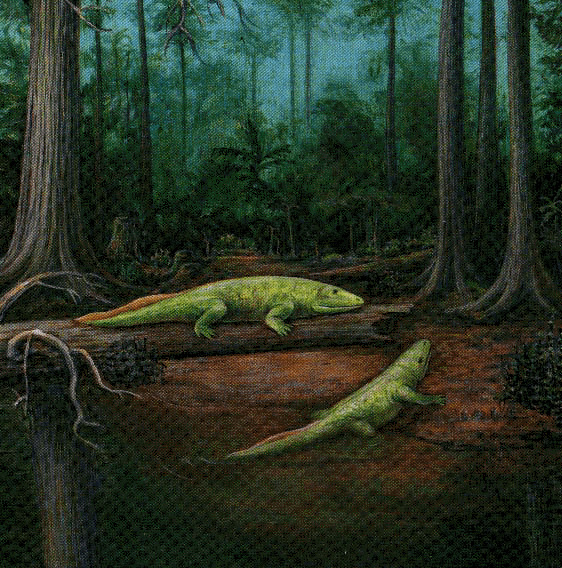
Life in the Devonian (R.
Scorpion & C.R. DeCorse)

While life spreads on
land, in the sea there thrive primitive fish species, like the armoured fish or
the cartilaginous fish (ancestors of the actual sharks and rays), in opposition
to the bony fish, which appeared later and are dominant today.
Carboniferous
During the Carboniferous period (which began 360 million years ago),
vast extensions of land were covered by dense forests of plants representing
groups that are minoritary today, like the already mentioned ferns.
Some land vertebrates began reproducing themselves through amniotic
eggs, which prevented that the animals became dry in their interiors. These
animals, the reptiles, started to put eggs on
land, overcoming the amphibians in what concerns to their capability for
adapting to a non-aquatic environment and, therefore, they achieved to expand into
the interior of the continents.
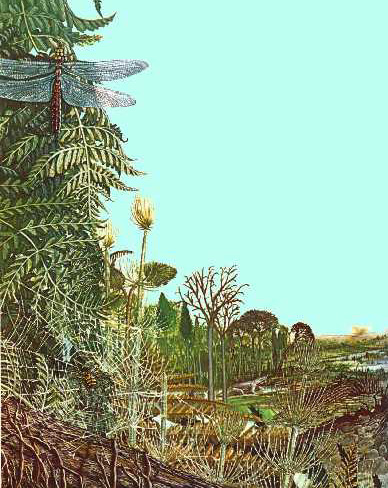
A carboniferous forest. Above, to the left: a meganeura, the
largest insect that ever existed (Adrian Sington)

Above: the Eogyrinus, an
amphibian from the Carboniferous period; below: the Hylominus, the most ancient
reptile known, which lived during the Carboniferous period (Adrian Sington)
Permian
The Permian period began 285 million years ago and was characterized by
the dryness of the interior of the super-continent that had been formed then –
the Pangæa. The reptiles with an appearance similar to the mammals (mammal-like
reptiles) thrived during this period. They typically had a bone structure and a
dentition similar to the mammals’ and sometimes they had their bodies covered
with hair.
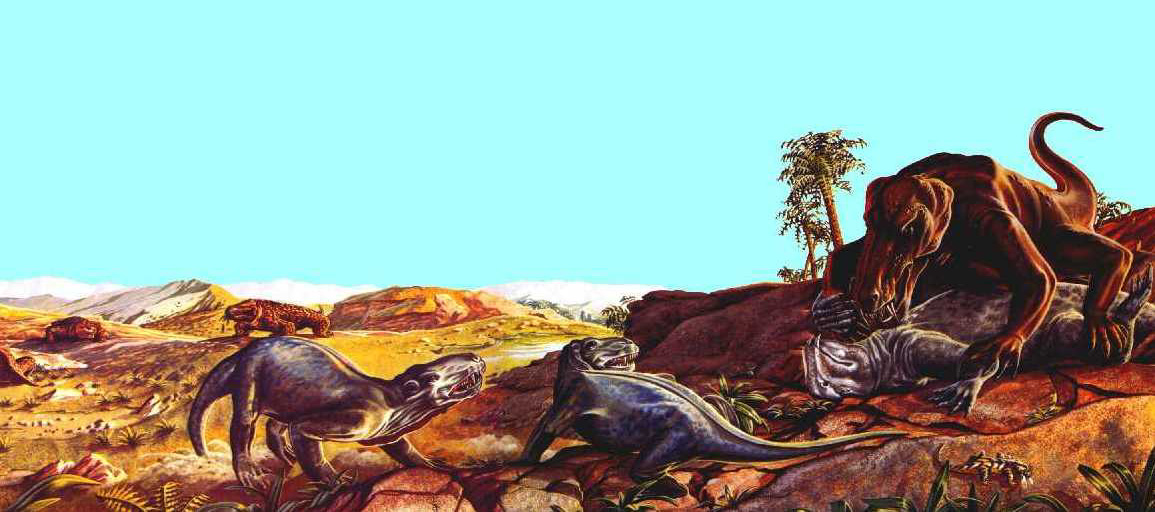
A Permian scenario: In
the foreground, two mammal-like reptiles (Adrian Sington)
The Era
of the Dinosaurs
Triassic
At the end of the Permian period (245 million years ago) it occurred the
most catastrophic mass extinction that is known, caused by reasons that aren’t
yet known for sure. It was probably caused by disasters (large scale vulcanism,
release of sulphur from the mantle, acid rain) triggered by a collision with an
asteroid or a comet with a size between 6
and 12 km. A crater in the northwest coast of Australia, with a diameter of
about 200 km (larger than the Chicxulub crater in the Gulf of Mexico, related
with the extinction of the dinosaurs), may be related with this catastrophe.
Less likely this extinction may have also been cause by the impact provoked by
a supernova of a close star. High traces
of iridium found in rocks at the Permian-Triassic boundary layer favour the
first hypothesis. After the occurrence of this catastrophic event, the forests
of ferns (which reproduce themselves by spores) gave place to gymnospermic
plants’ forests (plants that reproduce themselves by seeds), and the Permian
reptiles gave place to the dinosaurs (which were also reptiles). The true mammals (similar to small shrews), descendant of the mammal-like reptiles,
appeared for the first time during this period. They arose also the earlier
flying vertebrates – the pterosaurs (reptiles) – which may have developed from
arboreal reptiles that soared between the trees. Some reptiles, like the
ichthyosaurs, the pleisiosaurs and the giant liopleurodons, followed the
inverse way and went back to the water, just like the ancestors of mammals like
the whales or the dolphins did in the past or like
the walruses, the seals or the sea lions are doing today.

A Scene of the Triassic:
To the left, the fearful Postosuchus (a reptile that existed before the
dinosaurs); to the right, two Placerias (mammal-like reptiles) (Martin Hendry)

The Peteinosaurus, one of
the earliest pterosaurs of the Triassic (Martin Hendry)
Jurassic
It was during the Jurassic period (which began 208 million years ago)
that the descendants of the first birds started to thrive,
having with the scales already transformed into feathers but still endowed with
teeth at their beaks, with a reptile-like bone structure and claws at the tips
of their wings. Later, they surrendered the pterosaurs as the dominating
species of the skies. It’s believed that the birds are more ancient than the
dinosaurs and they shall descend from warm-blood reptiles, so that their
feathers could become an advantage for the animals – the feathers helped them
to keep their internal.

Jurassic landscape (Adrian
Sington)

Two minoritary groups of
the Mesozoic - above: the Archæopteryx (one of the most ancient birds known),
from the Jurassic period; below: the Tæniolabis, a mammal of the cretaceous
period, representative of a group originated in the Jurassic - the
multi-tuberculated mammals (Adrian Sington)
Cretaceous
The division of the Pangæa, which began in the Jurassic period, was
reinforced during the Cretaceous (which began 146 million years ago) and
fomented increasing differences between the fauna and flora of the various
regions of the globe. More modern birds and mammals, along with the first
flowered plants (namely, the magnolias) appeared or started to thrive during
the Cretaceous, being the most primitive ones deprived of colours and smell.
The appearance of the flowers encouraged the simultaneous appearance of several
groups of insects that depend on them, like the butterflies and the bees.
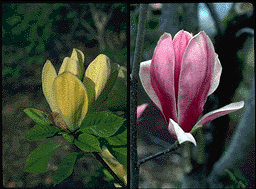
Magnolias (John Frett)
The Great Impact of Chicxulub
A meteoritic impact that occurred 64,7 million
years ago close to the coast of Mexico shall have put an end to the era of the
dinosaurs and other previously important animals, like the ammonites and
belemnites (cephalopods). Huge fires and sea earthquakes
seem to have been immediately caused by this event. A dark cloud of debris
thrown by the impact to the atmosphere shall have provoked a period of darkness
and global coldness during a decade, a phenomenon that shall have been the
final responsible factor for the extinction of the animals.
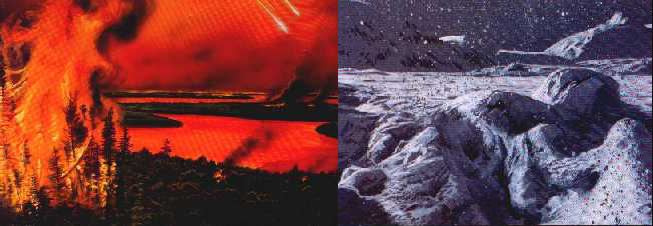
The impact of Chicxulub:
The few hours of fires, land and submarine earthquakes are followed by months
of harsh cold and darkness (Ron Miller)
The Era
of the Mammals
The extinction of the dinosaurs paved the way for the success of the
mammals, which from then on grew in size and occupied the supreme place of the
hierarchy of the planet’s animal life. The mammals are divided in 3 main
groups: the monotremes (the most primitive), the marsupials and the placentary
mammals.
The monotremes, like the reptiles, put eggs. However, they have their bodies
covered by hair, they are warm-blood animals (able to regulate their internal
temperature, independently of the external temperature) and they breast feed
their offspring.
Opposite to the monotremes, the marsupials and the placentary mammals
bear active babies. However, the marsupials have very simple placentas, so the
baby, when is born, is still at a very premature stage. It climbs to the
mother’s pouch and it breast feeds and grows there.
On the other hand, the placentary babies are already born at a quite
developed stage. It was during the primordial times of the Terciary period (the
period that followed Cretaceous) that the first primates arose, the group of animals to which the humans belong.

An ornithorhynchus, which
is a monotreme (Graham Allen)
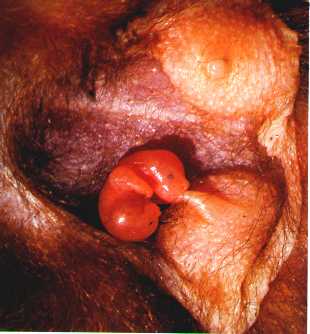
A newly-born marsupial in
the pouch of its mother